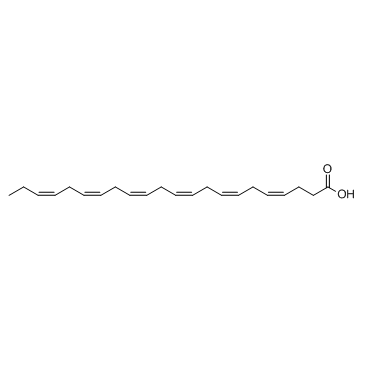Docosahexaenoic Acid (DHA) (Synonyms: Single-Use Cervonic Acid (peroxide free), Single-Use DHA (peroxide free)) |
| Catalog No.GC30765 |
Docosahexaenoic Acid (DHA) is an omega-3 fatty acid abundantly present brain and retina.
Products are for research use only. Not for human use. We do not sell to patients.

Cas No.: 6217-54-5
Sample solution is provided at 25 µL, 10mM.
Docosahexaenoic acid (DHA) is a long-chain polyunsaturated fatty acid with activities in both infants and adults [1]. Docosahexaenoic acid (DHA) is a structural constituent of membranes specifically in the central nervous system. Data from cell and animal studies justify the indication of DHA in relation to brain function for neuronal cell growth and differentiation as well as in relation to neuronal signaling [2].
Docosahexaenoic acid (10-30 µM 48 h) treatment induced apoptosis in three colon cancer cell lines (HT-29, HCT116 and SW480), and inhibited their total and surface GRP78 expression. The cell ability to undergo DHA-induced apoptosis was inversely related to their level of GRP78 expression [3]. Doxorubicin chemosensitization of breast cancer cell lines by docosahexaenoic acid was cell-line selective, affecting MDA-MB-231 and MCF-7dox (a doxorubicin-resistant cell line) but not the parental MCF-7 cell line [4].
Intravenous perioperative treatment with DHA (500 µg), resolvin D1 (RvD1, 500 ng) and maresin 1 (MaR1, 500 ng), 10 min and 24 h after the surgery, delayed the development of fPOP (mechanical allodynia and cold allodynia) in a mouse model of post-operative pain induced by tibial bone fracture [5]. Oral administration of DHA to normal adult mice as lysophosphatidylcholine (LPC) (40 mg DHA/kg) for 30 days increased DHA content of the brain by >2-fold. In contrast, the same amount of free DHA did not increase brain DHA, but increased the DHA in adipose tissue and heart [6]. Supplementation of the high-fat diet with either EPA, DPA or DHA prevented the fatty liver, prevented high serum cholesterol and serum glucose and prevented high liver cholesterol levels [7].
References:
[1]. Lien E L. Toxicology and safety of DHA[J]. Prostaglandins, leukotrienes and essential fatty acids, 2009, 81(2-3): 125-132.
[2]. Lauritzen L, Brambilla P, Mazzocchi A, et al. DHA effects in brain development and function[J]. Nutrients, 2016, 8(1): 6.
[3]. Fasano E, Serini S, Piccioni E, et al. DHA induces apoptosis by altering the expression and cellular location of GRP78 in colon cancer cell lines[J]. Biochimica et Biophysica Acta (BBA)-Molecular Basis of Disease, 2012, 1822(11): 1762-1772.
[4]. Maheo K, Vibet S, Steghens J P, et al. Differential sensitization of cancer cells to doxorubicin by DHA: a role for lipoperoxidation[J]. Free Radical Biology and Medicine, 2005, 39(6): 742-751.
[5]. Zhang L, Terrando N, Xu Z Z, et al. Distinct analgesic actions of DHA and DHA-derived specialized pro-resolving mediators on post-operative pain after bone fracture in mice[J]. Frontiers in pharmacology, 2018, 9: 412.
[6]. Sugasini D, Thomas R, Yalagala P C R, et al. Dietary docosahexaenoic acid (DHA) as lysophosphatidylcholine, but not as free acid, enriches brain DHA and improves memory in adult mice[J]. Scientific Reports, 2017, 7(1): 1-11.
[7]. Guo X, Sinclair A J, Kaur G, et al. Differential effects of EPA, DPA and DHA on cardio-metabolic risk factors in high-fat diet fed mice[J]. Prostaglandins, Leukotrienes and Essential Fatty Acids, 2018, 136: 47-55.
Average Rating: 5 (Based on Reviews and 16 reference(s) in Google Scholar.)
GLPBIO products are for RESEARCH USE ONLY. Please make sure your review or question is research based.
Required fields are marked with *




